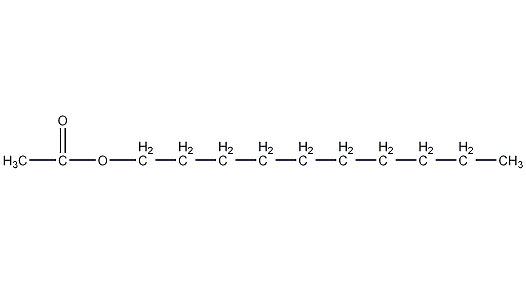
Structural formula
| Business number | 0356 |
|---|---|
| Molecular formula | C12H24O2 |
| Molecular weight | 200.32 |
| label |
Decyl acetate, Decyl acetate, n-decyl acetate, Decyl acetate, n-decyl acetate, capric acid ester, Acid 10 alkyl, Decyl acetate, Acetic acid capric ester, Acid decanoic ester, artificial flavors |
Numbering system
CAS number:112-17-4
MDL number:MFCD00026538
EINECS number:203-942-2
RTECS number:AG5235000
BRN number:1762123
PubChem number:24901023
Physical property data
1. Properties: colorless liquid with sharp, waxy aroma and sweet fruity aroma of pineapple-orange.
2. Density (g/mL, 20℃): 0.862-0.866
3. Melting point (ºC): -15
4. Boiling point (ºC , normal pressure): 244
5. Boiling point (ºC, kPa):
6. Refractive index: 1.425-1.430
7. Flash point (ºC ):>100
8. Solubility: Insoluble in water, soluble in 80% ethanol at a ratio of 1:2. Naturally found in oranges, lemons, melons, apples, etc.
9. Solubility: Insoluble in water, soluble in organic solvents such as ethanol.
10. Relative density (20℃, 4℃): 0.8671
11. Refractive index at room temperature (n20): 1.4273
12. Refractive index at room temperature (n25): 1.425
13. Relative density (25℃, 4℃): 0.841550
Toxicological data
1. Acute toxicity: Oral LD5O in rats: >5000mg/kg; Transdermal LD5O in rabbits: >5000mg/kg
2. Vaseline paste with a concentration of 8% is sealed in the human body for two days Sexual skin contact test found no irritation or sensitization reaction.
Ecological data
Slightly harmful to water bodies.
Molecular structure data
1. Molar refractive index: 59.41
2. Molar volume (cm3/mol): 230.0
3. Isotonic specific volume (90.2K ): 534.3
4. Surface tension (dyne/cm): 29.0
5. Polarizability (10-24cm3): 23.55
Computationalization�Data
1. Reference value for hydrophobic parameter calculation (XlogP): None
2. Number of hydrogen bond donors: 0
3. Number of hydrogen bond acceptors: 2
4. Number of rotatable chemical bonds: 10
5. Number of tautomers: none
6. Topological molecule polar surface area 26.3
7. Number of heavy atoms: 14
8. Surface charge: 0
9. Complexity: 132
10. Number of isotope atoms: 0
11. Determine the number of atomic stereocenters: 0
12. Uncertain number of atomic stereocenters: 0
13. Determine the number of chemical bond stereocenters: 0
14. Number of uncertain chemical bond stereocenters: 0
15. Number of covalent bond units: 1
Properties and stability
Avoid contact with oxides.
Properties: colorless liquid. It exists in various foods such as citrus, apple, melon and related essential oils. It is insoluble in water and soluble in 80% ethanol at a ratio of 1:2. Naturally found in oranges, lemons, melons, apples, etc.
Storage method
Store sealed in a cool, dry place. Make sure the workspace has good ventilation. Keep away from sources of fire. Store away from oxidizing agents.
Synthesis method
1. Made from the esterification of n-decanol and acetic acid. Acetic acid and decanol are obtained by direct esterification and azeotropic reflux dehydration.
2.Obtained from n-decanol and acetic anhydride through acid catalysis. Or it can be obtained by direct esterification of acetic acid and decanol and azeotropic reflux dehydration.
Purpose
1. Use a small amount in fragrance formulations. As a modifier for linalyl acetate. It is also commonly used in lily of the valley, jasmine, orange blossom, rose, geranium or aldehyde fragrance tops and fantasy fragrances to provide fresh fragrance. It can also be used as edible spices to make apple, berry, honey, sweet orange, peach, apricot, pear, pineapple, plum and other edible flavors and wine rum flavors.
2.It has been widely used in the preparation of food flavors and daily chemical flavors. It can be used to prepare food flavors such as berries, ether flavors, apples, sweet oranges, peaches, apricots, and pineapples, as well as wine flavors and tobacco flavors. Among them, the dosage of cold drinks, beverages to dessert puddings and chewing gum is 2.7~12 mg/kg, especially when added to citrus and rose flavors, it has a special flavor . Used as soap flavor, detergent flavor, perfume flavor, cream flavor, etc.

 微信扫一扫打赏
微信扫一扫打赏

